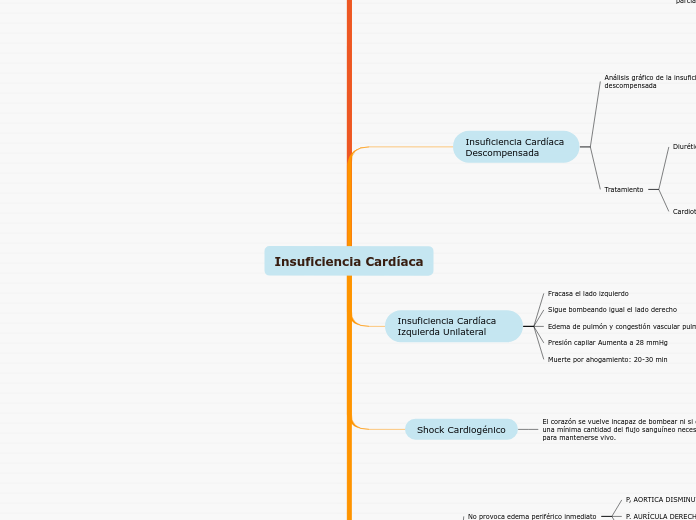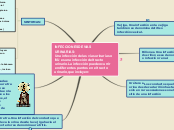Insuficiencia Cardíaca
To name your story, you have to think about the overall message and what you want your audience to understand from the story. Also, make it relevant and easy to remember.
Reserva Cardíaca
Adulto joven sano: 300-400 %
Deportista: 500-600%
DIAGNOSTICO
Prueba de esfuerzo con ejercicio
Aumento excesivo de la frecuencia cardíaca
Cansancio muscular extremo
Disnea Inmediata
ES
Porcentaje máximo que el gasto cardíaco puede aumentar por encima de lo normal.
Edema
Agudo de pulmón
Vaso dilatación periférica
DISMINUYE
El grado de oxigenación de la sangre
AUMENTA
Retorno venoso
Líquido en los pulmones
Presíon capilar pulmonar
Sangre en los pulmones
carga sobre el ventrículo izquierdo
Retención hídrica por los riñones
Péptido natriuirético
Ejerce efecto directo en los riñones
Liberado por
Las paredes de las aurículas al estirarse
causas
Activación del S.N.S
Aumento de secreción de aldosterona
Activación del sistema renina-angiotensina
Descenso de la tasa de filtración glomerular
No provoca edema periférico inmediato
17 a 13 mmHg
P. AURÍCULA DERECHA SE ELEVA
P, AORTICA DISMINUYE
Shock Cardiogénico
El corazón se vuelve incapaz de bombear ni si quiera una mínima cantidad del flujo sanguíneo necesario para mantenerse vivo.
Cateterismo de la arteria coronaria bloqueada.
Utiliza la infusión de sangre total, plasma o un fármaco hipertensor
La digital para reforzar el corazón
Circulo vicioso
Debilita al corazón
Reduce el aporte sanguíneo coronario
Presión arterial baja
Insuficiencia Cardíaca Izquierda Unilateral
Muerte por ahogamiento: 20-30 min
Presión capilar Aumenta a 28 mmHg
Edema de pulmón y congestión vascular pulmonar
Sigue bombeando igual el lado derecho
Fracasa el lado izquierdo
Tratamiento
Cardiotónicos
Mecanismo de acción
Aumenta la fuerza del miocardio del 50 al 100%
Aumento de la concentración de calcio intracelular
Disminución de la Bomba de Sodio-Calcio
Aumenta la concentración intracelular de sodio
Inhibición de la Bomba Na-K ATPasa
Diuréticos
Logra el equilibrio entre ingestión y eliminación de líquidos
Aumenta la excreción renal
Análisis gráfico de la insuficiencia cardíaca descompensada
Punto F
Disminución Frecuencia Cardíaca
Día 2
Día 1
Estimulación simpática máxima
Situación antes de cualquier compensación
Recuperación del corazón tras infarto
The ending of a story is essential. We all know that if the ending is weak, what happened before loses its importance. So make it unpredictable, but fair. A resolved ending answers all the questions and ties up any loose threads from the plot.
Curva de gasto cardíaco después de la recuperación parcial
This is the closure section of the story.
See examples of possible outcomes below:
- all problems have been solved
- it's clear how each one of your characters ends up
- your main character is transformed by the challenge
Punto D
Recuperación Parcial
Punto C
S.N. Simpático
Punto B
Try answering these questions in order for you to come up with a closure:
- Have all problems been solved?
- Is it clear what happens with all your characters in the story?
- Has the challenged transformed your main character?
- How do the characters feel in the end?
Daño al corazón
Punto A
Try answering these questions to come up with a closure:
- Have all the problems been solved?
- Is there a clear picture of what happens with each character in the story?
- Has the challenge transformed your main character?
- How do the characters feel in the end?
Normal
Estado final de recuperación en 5-7 semanas
This is the moment when the main character surpasses the last obstacle and finally faces their greatest challenge.
The climax usually follows one of these patterns:
- realization
- resolution
- choice
Type in your answer.
Recuperación dependiente del tipo de daño
Se hipertrofia la porción no dañada de la musculatura del corazón
Genera un nuevo aporte de sangre colateral
Retención Hídrica
The middle of the story is where you add layers of complications that will lead to the end. Reveal more about the character's journey. Did their personality go through changes? How did they overcome the challenges? And as you build up the story’s central conflict, make it more personal to that character. Also, from the middle act, you have to lead into the final act.
Efectos Negativos
Your character(s) need(s) motivation in order to solve the challenge(s).
Sobreestiramiento del corazón
Secondary characters might also have motives that lead them to cross paths with the main character or which might trigger them to help the main character.
Aumento de carga de trabajo
Why does your character need to confront this challenge? What does he/she expect to accomplish by solving it?
See a few examples:
- will marry in 3 days
- can fix the mistakes of the past
Filtración de líquido hacia los pulmones
Desarrollo de un edema extenso en la mayor parte del cuerpo
Secondary characters also might have motivs beacuse of which they may cross path with main character or which might trigger them to help the main character.
Aumento del retorno venoso
Each story has a main character and that character usually needs to solve a problem or challenge. The character's challenge is the one that creates tension throughout the story.
Distiende las venas
Type in any other challenges which other characters in the story need to face.
Reduce la resistencia venosa
Aumenta la presión media de llenado sistémico
In most stories, there are 3 challenges. The number 3 is a mystical number symbolizing completeness. Try to come up with interesting challenges with which your character needs to struggle.
See a few examples below:
- turns into a werewolf at night
- is sent back in time
Flujo venoso hacia el corazón
Tipos
Insuficiencia Cardíaca de alto gasto
Beriberi
Fístula Arteriovenosa
Insuficiencia Cardíaca Descompensada
Es un daño estructural que produce disminución de la fuerza contráctil del corazón
NO compatible con la vida
Insuficiencia Cardíaca Compensada
Es la normalización del gasto cardíaco en presencia de insuficiencia cardíaca
Compensado por el sistema nerviosos simpático
Es una afección en la cual el corazón ya no puede bombear sangre suficiente para satisfacer las necesidades del organismo
In the beginning of the story (or the exposition), you will need to introduce the setting and characters. You might also want to introduce the main conflict. This part of the story is important because it gives the reader necessary background information and maybe even a first insight into a character’s personality.
EFECTOS
The setting (time & place) of a story can change throughout the plot.
Estimulación Simpática aumenta
Sensory details include sight, sound, touch, smell, and taste. These details are important because they create depth in your setting.
See a few examples below:
- the smell of fresh bread
- the scent of freshly cut grass
- rain falling onto the windshield etc.
Presión de la aurícula derecha
Fluido de sangre al corazón
Presión media de llenado
Retorno Venoso
Fase Crónica
Disminución de la presión arterial
Producción de la orina
Anuria: Disminución del gasto cardíaco
Aumento del volumen de sangre que duran horas o días
Grados variables de recuperación del corazón
Retención hídrica en los riñones
Corazón y vasculatura periférica
The weather is an important element in your story because it can highly influence the ambiance and the mood of the characters.
Compensa parcialmente al musculo no funcional
Decide if you want to include an element of nature in your story. For example, a rainbow can be a very nice choice for a happy ending. The mist in a story can represent mystery and secrets. A thunder can appear in the background at the moment when the 'bad guy' of the story makes its appearance, etc.
Refuerza la musculatura dañada
Does your story include catastrophic weather? See a few suggestions below or add your own:
- hurricane, earthquake, storm, etc
Compensación por reflejos nerviosos simpáticos
The time of the story can also change. It can describe the event of a single day or can include an entire year's plot. Anyway, don't forget to mention it.
Reflejos de Quimiorreceptores
Reflejos de Barroreceptores
Efectos Agudos
Your story can take place wherever your imagination will take you to.
For example: in an elevator, in an enchanted forest, etc. Don't forget to give details of the environment each time the setting changes, otherwise, the story can be confusing. Also, mention the seasons as each of them has unique weather and events.
Aumento de la presión venosa debido al estancamiento de la sangre en las venas
Disminución del Gasto Cardíaco
CAUSAS
Characters are essential to a good story. Usually, the protagonist(s) is/are the most affected by the plot. Introduce a character by focusing on their actions, interests, and occupation, as the physical appearance doesn't make a difference in most cases.
Principales
Type in the name of your character.
Enfermedad del músculo cardíaca
Add other properties of the character.
Deficiencia de vitamina B
Add other qualities/attributes of the character.
Presión externa sobre el corazón
What is your character's main goal?
fight Evilfind lovedefeat his/her enemyrule the worldmake friendstime travelmake an awesome discoveryOther
Daño de las válvulas cardíacas
Which traits best describe the character's personality? Choose more if necessary:
introvertedloyalkindindependentquick-thinkingadventuresomeidealisticsweet-naturedcalmrisk-takercreativewittystrictfussyweirdclumsyharshaggressivecarelessclingingcowardlycrueldeceitfulimpulsiveOther
Disminución de la contractilidad del miocardio
Choose the type of your chacter:
Protagonist (main character)Antagonist (main character's opponent)Flat (stereotypical character)Round (his/ her personality develops throughout the story)Static (doesn't evolve as a person throughout the story)Dynamic (dramatical change in personality)Confidant (the main character trusts him/ her)Foil (contrasting character who enhances the personality of another character)Other










